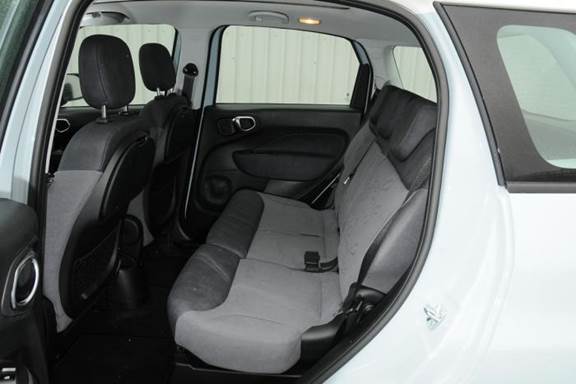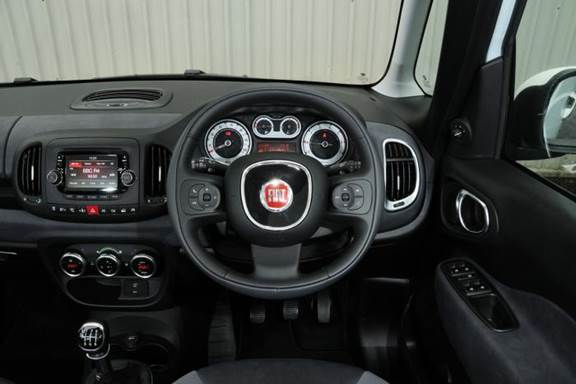Besides this 1.6-liter turbo-diesel, Fiat also offers a 1.4-liter naturally aspirated petrol. We’d recommend an extensive try-before-you-buy approach, as our test vehicle weighed a portly 1.5 tons that might overwhelm the latter which otherwise performs ably in the 500.

The test unit’s MultiJet motor is well suited the 500L, in fact. Look past the leisurely zero-to-100 km/h time of 14.46 seconds – the engine won’t rev faster than 2,500 r/min when stationary, necessitating some clutch slip to achieve that time – and rather to the in-gear acceleration, which is strong enough for this version to never feel malnourished.
That said, the gearing is long, necessitating a change to first in slow-moving traffic, second up steep hills and fifth during over-taking. Conversely, this means the turbo diesel fades into the background at the national limit, which is just as well, as the 500L certainly isn’t immune to annoying wind flutter around the large windscreen and side mirrors.

Dynamically, the 500L has few failings. The electric power steering is light (it can be lightened further by pressing the City but-ton on the facia), but naturally weighted, though it exhibits a firm resolve to self-center at any opportunity, and the six-speed manual shifts cleanly and the lever is perfectly placed.
Ride comfort is equally good. It’s just firm enough so that the sprites seated at the back don’t become green-gilled from roly-poly body motions, but not harsh enough to shake loose their milk teeth. Handling is much of a muchness; the 500L resists roll well but the front soon washes into unders-teer if the mom or dad behind the wheel becomes overly excited.
One element of the 500L’s dynamic repertoire that didn’t garner universal praise is the braking performance. It’s good in day-to-day use, but proved somewhat weak in our emergency-braking tests, scoring a middling average of 3.30 seconds after 10 stops. Safety equipment comprises, inter alia, six airbags, ABS with EBD and EBA and a traction-control system. The 500L scored five stars for overall crash protection in a recent round of EuroNCAP tests.

Test summary
We liked the 500L, even more than we thought we would. Even the Sceptical Simons on the team had to admit that, beyond the questionable use of the 500-name, it’s a vehicle with a fair few arrows in its quiver. As a compact family vehicle, it’s expertly judged: the size is right, the cabin roomy and practical, the engine strong enough and frugal, and the price is quite reasonable given the inclusive three-year maintenance plan. In fact, the 500L is so good that it could have easily done without the weight of expectation created by its nomenclature; it has an identity all its own.
Specifications
Price: $27,375 Engine Cylinders: four, inline, transverse Fuel supply: electronic common-rail direct injection, turbocharged, intercooled diesel Bore/stroke: 79.5 / 80.5 mm Cubic capacity: 1,598 cm3 Compression ratio: 16.5 to 1 Valve gear: d-o-h-c, four valves per cylinder Engine output Max power ISO (kW): 77 Power peak / Red line (r/min): 4,000/5,000 Max torque (N.m): 320 Torque peak (r/min): 1,750 Transmission Type: six-speed manual 1st gear / 2nd gear: 3.80/2.24 to 1 3rd gear / 4th gear: 1.36/0.97 to 1 5th gear / Top gear: 0.76/0.61 to 1 Reverse gear: 3.55 to 1 Final drive: 3.55 to 1 Drive wheels: front Driver aids: ESC (Electronic Stability Control), hill start Wheels and tires Tire make: Continental Conti Eco Contract 5 Tire size: 205/55 R16 Spare-type and location: space-saver, under boot board Brakes Front: 284 mm ventilated discs Rear: 251 mm solid discs Hydraulics: ABS with EBD and EBA Steering Type: rack and pinion, electric power assist Lock to lock: 3.0 turns Turning circle diameter: 11.1m Suspension Front: MacPherson struts, coil springs, anti-roll bar Rear: torsion beam, coil springs Capacities Seating: 5 Fuel tank: 50 liters Boot / utility space: 296-352/1,144 dm3 Homologated tow rating (unbraked): 400 kg Warranty and service intervals 3 year/100,000 km warranty, 3-year/100,000 km maintenance plan, Service every 20,000 km |